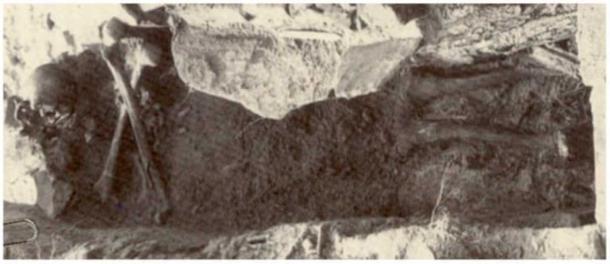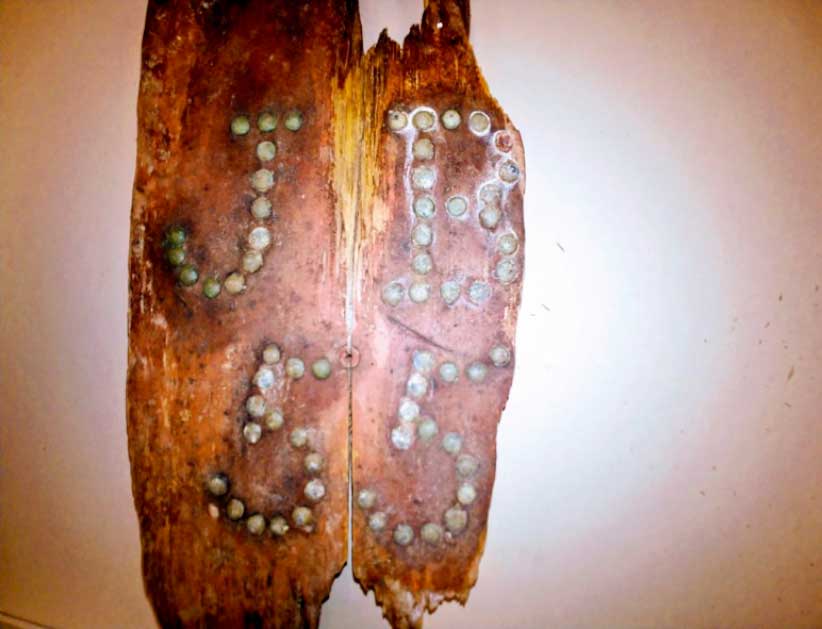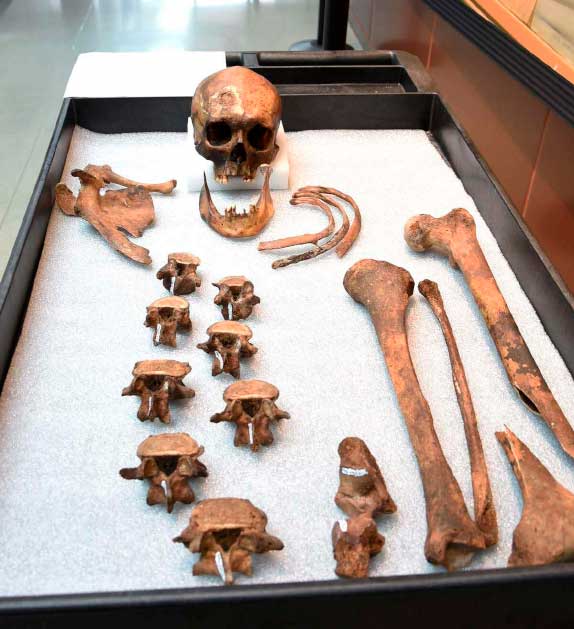
Face of 19th Century American 'Vampire' Reconstructed
Based on the DNA extracted from a 19th century skeleton, a forensic artist has recreated the face of a man who was buried, but never laid to rest. Mr. John Barber’s body was later dug up so that his corpse could be crippled, because he was suspected of being a vampire.
The so-called vampire was buried in Griswold, a quiet town in New London County, Connecticut, New England. It was here in the mid-19th century that the Jewett City vampires allegedly terrorized the Rays, a family of farmers who lived in Griswold in the 1840s and 1850s. After their deaths, members of the Ray family claimed they were “plagued by vampires.” This Griswold family became so paranoid that in 1854, their descendants disinterred and burned the bodies of dead relatives, attempting to hinder “the undead” from returning to this world.
Now, using DNA evidence, a team of forensic scientists have created a facial reconstruction of one of these alleged 19th century vampires. This one was also dug up and reburied in Griswold, but rather than being burned, his femur bones were crossed on his chest. According to a report in LiveScience, this specific placement of bones indicates that locals regarded him as a vampire.
- How Long Have We Believed in Vampires?
- Researchers suggest cholera may be behind 17th century vampire graves

The 19th century grave of JB55 in Griswold, Connecticut, showing the remains arranged in a manner to prevent the ‘vampire’ from rising and "feeding" off the community. (Jennifer Daniels-Higgenbotham / CC BY 4.0)
JB55: The Griswold Vampire
The team of forensic scientists from Parabon NanoLabs, a DNA technology company based in Virginia, worked with the Armed Forces DNA Identification Laboratory (AFDIL), a branch of the U.S. Armed Forces Medical Examiner System based in Delaware.
Officially known as JB55, archaeologists originally unearthed the 200-year-old remains in 1990. In 2019, a team of forensic scientists extracted his DNA and compared it to a genealogical database. They discovered that the man was named John Barber, and the title JB55 was derived from the epitaph marked out on his coffin in brass tacks, denoting his initials and the age he died.
Evidence gathered in 2019 showed that Mr. Barber had not been resting in peace. On the contrary, some years after his death, his body was dug up and reburied, with his head and limbs piled on top of his ribcage, forming a cross shape. This unexpected burial style, according to New England historians, is associated with those people who were suspected of being vampires.
- 'Vampire Burial' An Effort to Prevent a Child's Infectious Return From the Grave
- Jure Grando and The First Documented Case of Vampirism in Europe

A fragment of the coffin that held the remains of the man believed to be John Barber is hardwood, decorated with brass tacks hammered into the initials "JB55." (Courtesy of Connecticut State Archaeologist)
The Connection between Vampires and Consumption
The new DNA analysis has determined that Mr. Barber was about 55 years old when he died. Furthermore, evidence suggests the ‘vampire’ had suffered from consumption (now referred to as tuberculosis.) In a statement, the team of scientists said that in 19th century New England, tuberculosis was often misinterpreted as a vampirical attack.
According to History.com, tuberculosis was thought to be caused by the deceased consuming the life energy of their surviving relatives. Buried bodies were sometimes later exhumed and the bones were reassembled into Christian crosses by people who believed in vampires. When the bodies were burned in a sort of ritual defense against the suspected vampires attacking the entire population, unbeknownst to the people, the burning helped prevent the spread of the tuberculosis outbreak.
Ellen Greytak, director of bioinformatics at Parabon NanoLabs, told LiveScience that in the case of JB55, his remains were found with “the femur bones removed and crossed over the chest." This was a way to prevent the vampire rising from its grave and “walking around attacking the living”.

The skeleton of the Connecticut ‘vampire’ on display at the National Museum of Health and Medicine in Silver Spring, Maryland on July 23, 2019. JB-55 is believed to be a man named John Barber who died of tuberculosis. (Tech. Sgt. Robert Trujillo/National Museum of Health and Medicine)
The Challenges of Scanning a Vampire
The DNA analysis used to build a new 3D facial reconstruction revealed that vampire JB55 was fair skinned, and perhaps speckled with freckles. Additionally, the genetic data demonstrated that he had brown or hazel eyes, and DNA signatures also determined he had dark hair.
Greytak explained that the specific technology used to gather the DNA evidence “doesn't work well with historical bones,” which fragment and decompose over time. But this challenged inspired the team, as the project leader said it was an opportunity to demonstrate that DNA could indeed be extracted from “difficult historical samples."
Top Image: Left 3D scan of JB55's skull with tissue depth markers helped guide the ‘vampire’s’ facial reconstruction. Right- Forensic facial reconstruction of JB55, a Connecticut man suspected of being a vampire. Source: Parabon NanoLabs, Inc
By Ashley Cowie
References
19th Century New England Vampire Undergoes 21st Century DNA Analysis. October 30, 2022. Parabon Labs, Inc. Available at: https://www.einnews.com/pr_news/598602717/19th-century-new-england-vampire-undergoes-21st-century-dna-analysis
Flood, R. October 31, 2022. Skull of Mutilated 'Vampire' From 1800s Reveals What He Really Looked Like. Newsweek. Available at: https://www.newsweek.com/skull-mutilated-vampire-1800s-john-barber-1755758
Kent, D. 2007. Ghost Stories and Legends of Eastern Connecticut. The History Press.
Nalewicki, J. November 1, 2022. See the face of an 18th century 'vampire' buried in Connecticut. LiveScience. Available at: https://www.livescience.com/vampire-burial-dna-connecticut
Ponti, C. October 31, 2019. When New Englanders Blamed Vampires for Tuberculosis Deaths. History.com. Available at: https://www.history.com/news/vampires-tuberculosis-consumption-new-england
















Comments
This grave, and a few others associated with it, almost got lost to history. The graves were probably part of a small family or local cemetary that either had wood markers that deteriorated, or stones that were removed, moved or lost. A sand quarry ran for decades on the land and was still in business when my driveway/road wound around the property through the woods.. One weekend some kids were playing in the quarry, “sledding” in the sand (I won’t go into the potential danger of this, or that the kids were trespassing!) when what they thought was a rock rolled down alongside them. It turned out to be a skull. Eventually the state archeaologist was notified, after police determined the skull was not part of a crime scene. At the top of the sand cliff, the rest of the skeleton was found, along with a couple other graves. The team immediately realized the uniqueness of the grave, and recognized that the body had been interfered with after the original burial.
Griswold, Connecticut is not very far from Exeter, Rhode Island, which had its own vampire, a young woman named Mercy Brown who probably died of TB, which then sickened other family members. Her body was secretly exhumed in 1892, the heart removed and burned, the ashes then mixed with something - water? wine? – and given to those family members for "protection” from their sister and daughter. It didn’t work; others in her family also died of TB.
I didn’t realize that DNA had been successfully extracted from the Griswold “vampire’, and it’s interesting that the man looks alot like a “typical” old Yankee farmer. There are many with that work-weary face even today, people who work on the land. Their families came from many places, but most were of English, Scottish and northern European decent.
Actually, it doesn’t. It does NOT tell HOW they get from DNA to facial characteristics. But as I said, easiest way is to find the closest living DNA match, and use that person’s face, at least as a starting point. In reading what that partnered (in the study) DOD agency does – https://en.wikipedia.org/wiki/Armed_Forces_DNA_Identification_Laboratory – hmmm, seems I’m right. They matched somebody up, looks to be a senior member, maybe a General or Sergeant Major. https://upload.wikimedia.org/wikipedia/commons/a/ab/General_Mark_A._Milley_%28cropped%29.jpg The modern version?
Nobody gets paid to tell the truth.
The video also explains how his face was reconstructed.
I’m talking about the photo, not John Barber. Somebody’s DNA (living or dead, where photo exists in the database) MOST closely matches John Barber’s, and probably related in some close or distant way. Of course, they wouldn’t use his real name.
Nobody gets paid to tell the truth.
No, John Barber
Pages